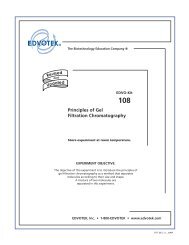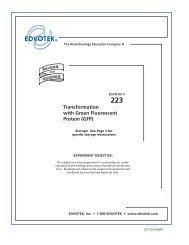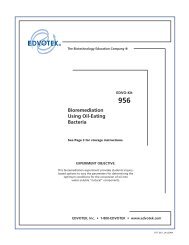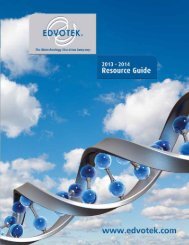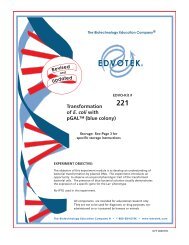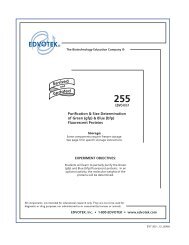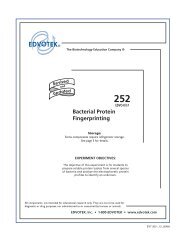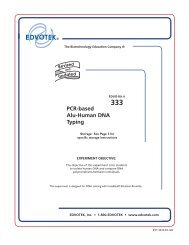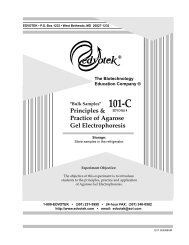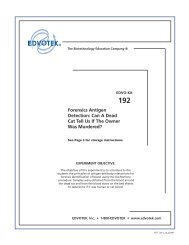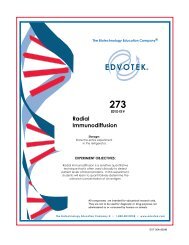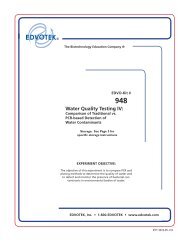953 - EDVOTEK
953 - EDVOTEK
953 - EDVOTEK
You also want an ePaper? Increase the reach of your titles
YUMPU automatically turns print PDFs into web optimized ePapers that Google loves.
28<br />
EDVO-Kit #<br />
<strong>953</strong><br />
Appendix B<br />
Polymerase Chain Reaction Using Three Water baths<br />
Superior PCR results are obtained using an automated thermal cycler. However, if you do not have a thermal<br />
cycler, this experiment can be adapted to use three water baths (Cat. # 544). Much more care needs to be<br />
taken when using the three-water bath PCR method. The PCR incubation sample is small and can easily be<br />
evaporated. Results using three water baths are often variable. Please refer to the Appendix entitled "PCR<br />
Samples with Wax Overlays" for sample handling and preparation tips.<br />
Each PCR Reaction pellet<br />
contains Taq DNA polymerase,<br />
four deoxytriphosphates, Mg +2<br />
and buffer.<br />
Preparation of the PCR Reaction:<br />
1. The PCR reaction sample should be prepared as specified in the experiment<br />
instructions. Each PCR reaction sample contains three critical components:<br />
• PCR Reaction pellet<br />
• Primer mix<br />
• DNA for amplification<br />
2. After adding the components of the PCR reaction sample, use clean forceps<br />
to transfer one wax bead to the PCR tube. At the start of the PCR reaction,<br />
the wax will melt and overlay the samples to prevent evaporation during<br />
heating.<br />
POLYMERASE chain reaction CYCLING<br />
Important Note<br />
It is imperative that the<br />
temperatures are accurately<br />
maintained throughout the<br />
experiment.<br />
3. In the three-water bath PCR method, the PCR reaction sample is sequentially<br />
cycled between three separate water baths, each set at different temperatures,<br />
for a specified period of time. The sequential placement of the reaction<br />
sample in the water baths maintained at three different temperatures<br />
constitutes one PCR cycle. One example of a PCR cycle might be as follows:<br />
94°C for 1 minute<br />
50°C for 1 minute<br />
72°C for 1 minute<br />
See experiment instructions for specific program requirements.<br />
4. The PCR tube must be handled carefully when sequentially cycled between<br />
the three water baths. For each cycle:<br />
• Carefully place the PCR tube in a water bath float. Make sure that the<br />
sample volume is at the bottom of the tube and remains undisturbed. If<br />
necessary, pulse spin the tube in a balanced microcentrifuge, or shake<br />
the tube to get all of the sample to the bottom of the tube.<br />
• Use forceps to carefully lower the water bath float (with tubes) sequentially<br />
into the water baths.<br />
5. Process the PCR reaction sample for the total number of cycles specified in<br />
the experiment instructions. On the final cycle the 72°C incubation can<br />
be extended to 5 minutes.<br />
6. After all the cycles are completed, the PCR sample is prepared for electrophoresis.<br />
Duplication of this document, in conjunction with use of accompanying reagents, is permitted for classroom/laboratory<br />
use only. This document, or any part, may not be reproduced or distributed for any other purpose without the<br />
written consent of <strong>EDVOTEK</strong>, Inc. Copyright © 2006, 2008, 2009 <strong>EDVOTEK</strong>, Inc., all rights reserved<br />
EVT 090205K<br />
The Biotechnology Education Company® • 1-800-<strong>EDVOTEK</strong> • www.edvotek.com




